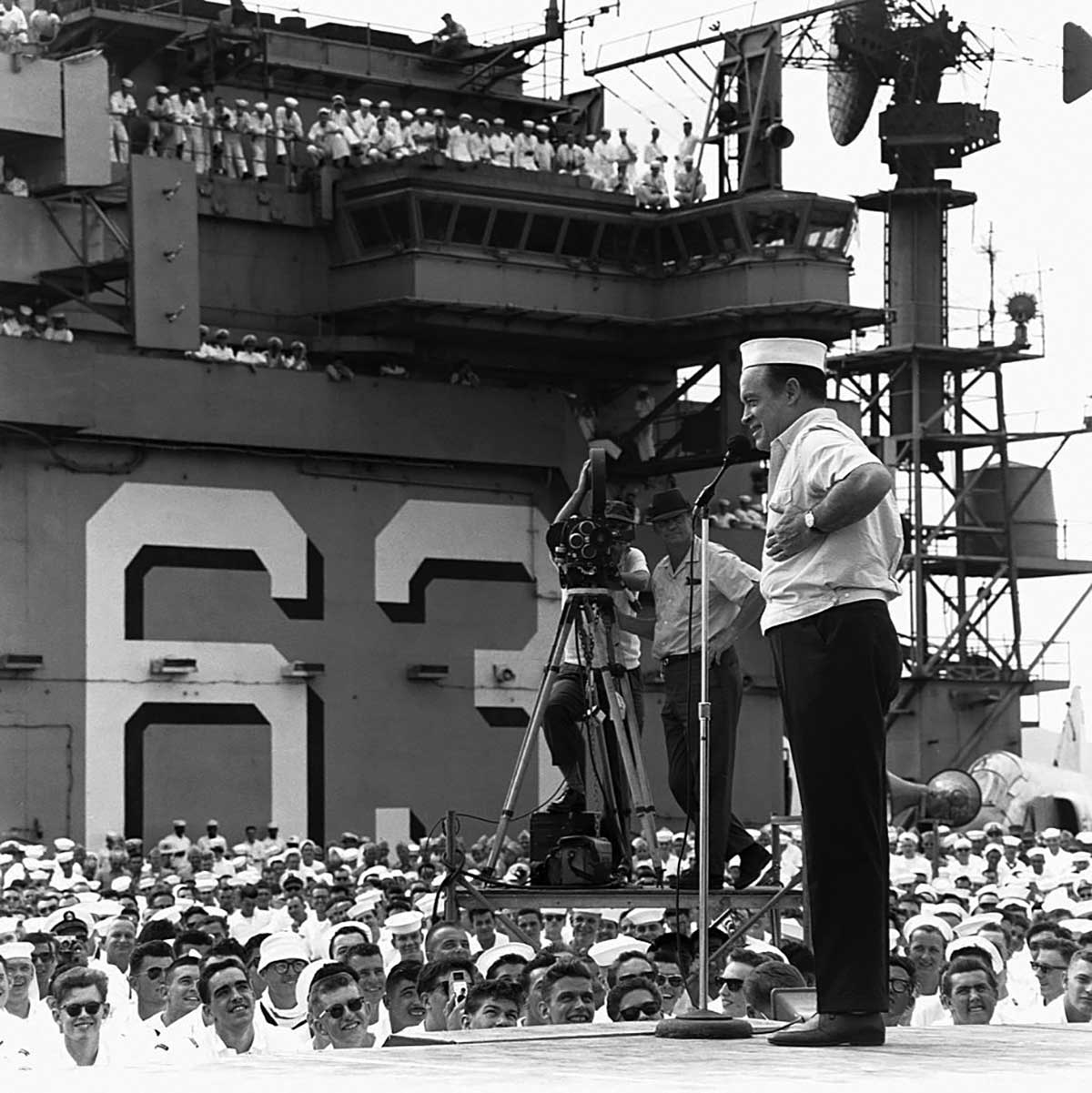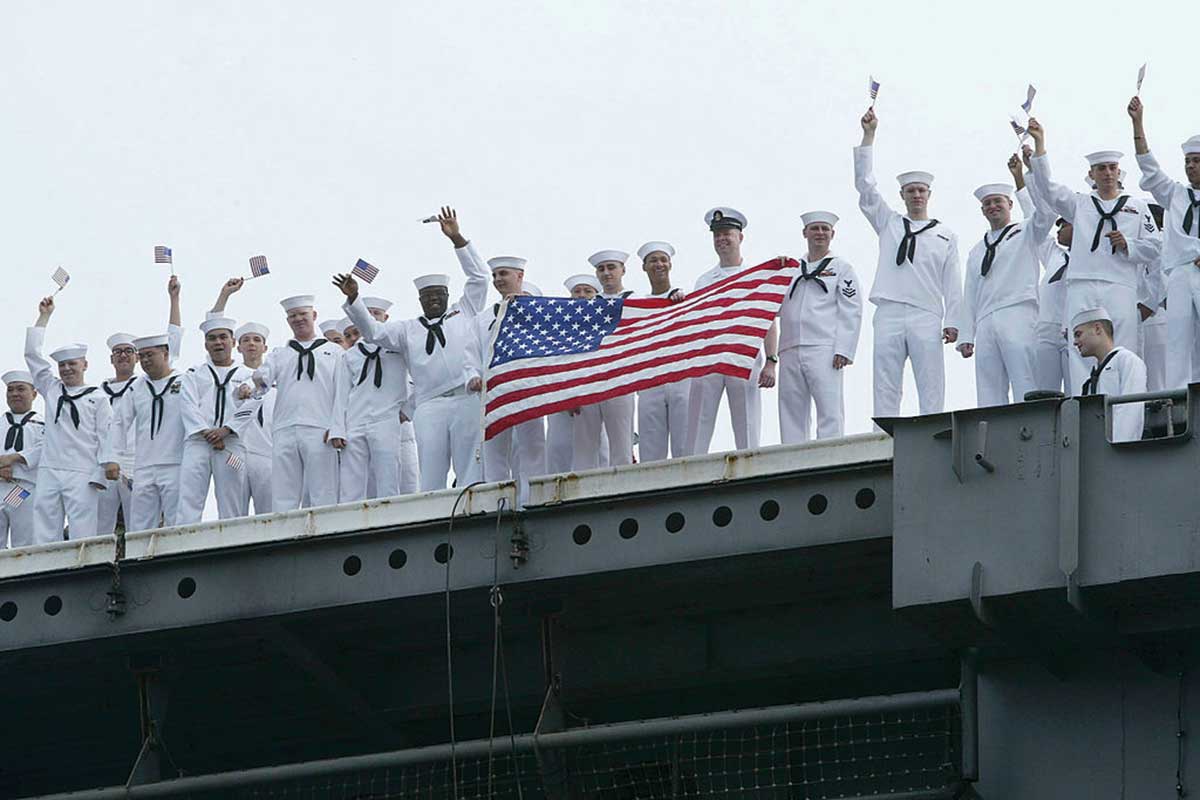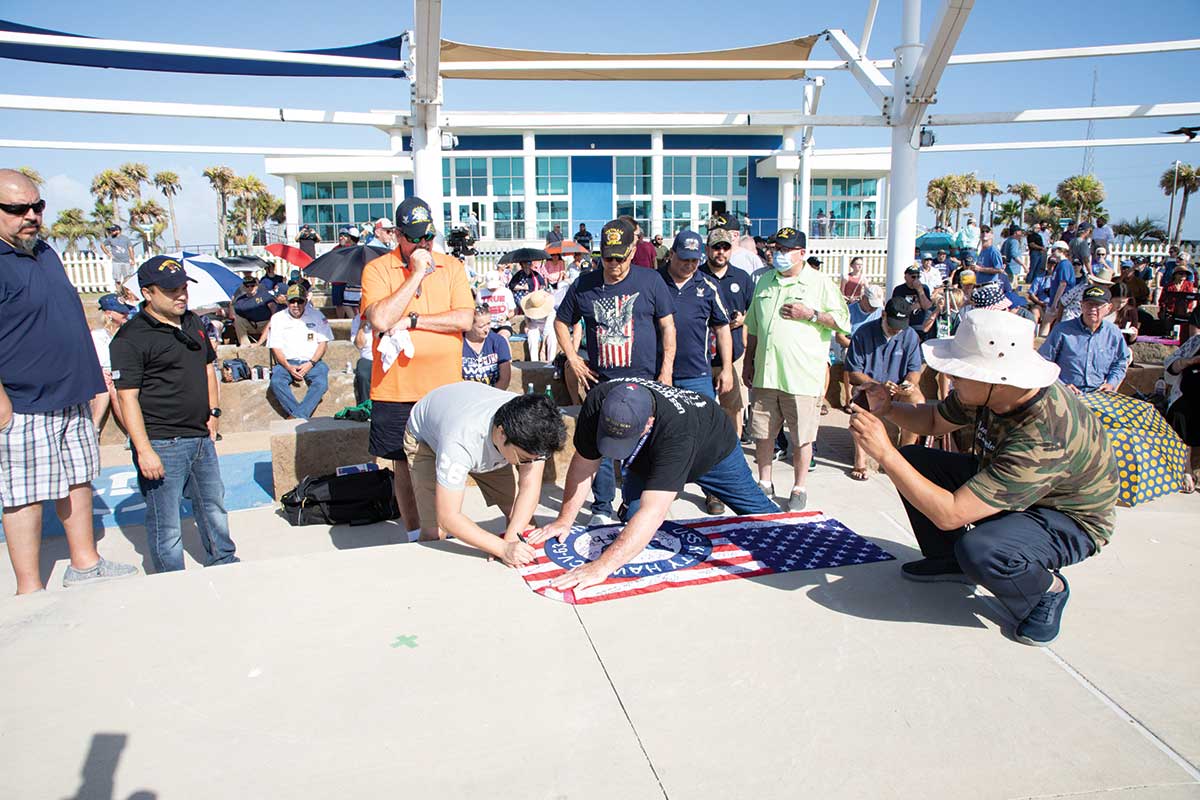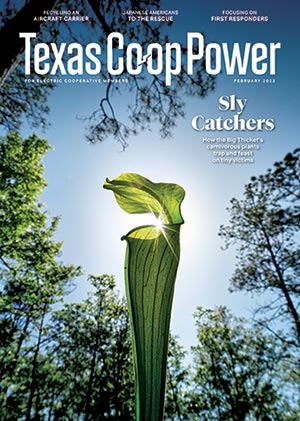David Gross stands among about 5,000 men and women who served on the USS Kitty Hawk between 1961 and 2009 as the towering supercarrier is towed through Brazos Santiago Pass.
They’re crowded onto South Padre Island’s south shore to pay their respects and reminisce about the extraordinary aircraft carrier that had been their home away from home.
That home moved around: Vietnam and Afghanistan, in the Persian Gulf and Arabian Sea, but mostly in the western Pacific, until it was retired 14 years ago as the last conventionally powered American carrier. But today, after 48 years of active service, the decommissioned ship arrived at the Port of Brownsville, never to sail again.
Watching the Kitty Hawk head to the recycling yard is “kind of like having the house you grew up in torn down,” says Gross, who came from San Diego to see the carrier one last time. He served as a roof rat—part of the flight deck crew—40 years ago.
Veterans—from the Silent Generation, baby boomers, Gen Xers and millennials—roar in pride and appreciation as Gross raps out a long, proud tribute: “We are the Kitty, and we ride the back of a Hawk. We were young. We were strong, working day and night long—12 on and 12 off, jet exhaust we did cough. Yeah, we’re the crew of the Kitty, and we walk the walk.”
Oceanfront Home
The Kitty Hawk, a small floating city (population 5,280) with a major airport, housed the ship’s company, deployed air wing and the admiral’s staff. Essential duties of those onboard ranged from air traffic controller, jet mechanic, roof rat and parachute rigger to pilot, electrician and cook working in 12-hour shifts. Many sailors were teenagers when they first came aboard and formed enduring bonds with their ship and shipmates.
“The Kitty was by far my favorite ship. Everyone had a can-do attitude,” says Gordon Wilcox, a 21-year veteran who served two tours on the carrier. The Alvarado resident and United Cooperative Services member initially photographed shipboard events for news releases. Later he worked with reconnaissance cameras used by pilots.

Bob Hope entertains aboard the USS Kitty Hawk in the Philippines in 1962.
Corbis | Getty Images
Aviation electrician A.J. Reynolds served two tours on the carrier. “I was 18 or 19 when I first went on the Kitty Hawk,” says the Bandera Electric Cooperative member.
“It was special. I’ll never forget it.”
His sentiment was echoed by Joseph Houck of Somerset, who was aboard 1989–93. He came to South Padre to see the first ship on which he had served and recalled watching dolphins racing alongside as the carrier reached 30 knots.
“For fun, we had roller chair derbies during sea trials,” he says.
Jet engines once roared as catapults launched Phantoms, A-6s and Hawkeyes from the carrier’s short deck. Coupled with the shrill whines of fighters and reconnaissance planes landing and coming to abrupt stops as their tail hooks caught a cable on the deck, sailors’ attempts at sleeping could get complicated.
Another complication occurred in March 1984, when a nosy Soviet sub passed directly in front of the Kitty Hawk in the Sea of Japan. The carrier plowed over the nuclear vessel, which rolled underneath it. The sub remained mostly intact but left behind a propeller in the carrier’s bow, a Cold War triumph still celebrated by the Kitty’s crew. Sailors fondly remembered, too, the superb seamanship of the captain who heeled over the Kitty Hawk to pass under the Golden Gate Bridge without taking off the antennas.
Rich Orth was onboard for the Kitty Hawk’s first voyage around the Horn of Africa in 1961, and he was among the 68 civilians invited on board for its last powered cruise, from San Diego to a reserve fleet at Bremerton, Washington. “It was a different Navy back then,” he says. “Nothing compared to the Hawk.”
Gone From Sight
Looming 140 feet above the water, taller than most island condo buildings, the Kitty Hawk slid past its devotees May 31, 2022, en route to the Brownsville Ship Channel while tour boats and fishing boats flitted around it like tiny remoras nibbling on a whale.

Sailors wave American flags as the supercarrier returned to a Japanese port in 2003 after operations in the Persian Gulf.
Koichi Kamoshida | Getty Images
The Kitty Hawk came to rest at International Shipbreaking Limited after being towed almost 17,000 miles from Bremerton. ISL is one of three companies in the U.S., all in Brownsville, that meet the strict environmental, safety and health standards required to dismantle Navy and U.S.-flagged ships. ISL counts the aircraft carriers Independence, Ranger and Constellation among more than 80 U.S. Navy and Maritime Administration vessels it has recycled since 1995.
ISL has a service contract with the Navy for each ship, secured by a penny payment, says Bob Berry, the company’s co-founder and vice president. “We don’t own the ship.” But once pieces are cut up and set on the ground, they do own the salvaged metal. “Salvage material goes out by barge, rail and truck all over the world, depending on the best prices on the steel scrap market,” he says. Armored steel plating, made with special alloys, is destined for a Pennsylvania mill that will remake it for use in other Navy ships.
By May 2024, 60,000 tons of metal (a remarkable 95% of the ship) will have been recycled from the Kitty Hawk, according to Berry. “We’ve done enough ships that we know exactly how much metal comes out,” he says. With all their stainless and structural steel, aluminum, brass, and copper, ships are among the most recyclable manufactured products. (Cars are 65% recyclable.)
A monitor over Berry’s desk shows views of the busy, noisy 80-acre recycling yard. He explained the Kitty Hawk first underwent environmental and safety inspections before a contractor removed asbestos and flammable materials. Then rectangles, 8 feet by 10 feet, were cut into the hull superstructure and folded outward like a sardine can lid to provide work crews with natural light and ventilation. After removing wiring and pipes for recycling, ISL employees use cutting torches to break up the 1,047-foot-long ship into sections.

Kitty Hawk veterans sign a commemorative flag near Brazos Santiago Pass.
John Faulk
Gawky cranes with giant magnets and grapples remove modular sections of the ship in the reverse order of their assembly 60-plus years ago at a New Jersey shipyard. The towering structure known as the island, or mast, was the first section cut loose and lowered to the ground. The sections swung from the ship to shore weigh up to 10 tons each. Hydraulic shears and torches reduce the metals to manageable chunks. The carrier’s four main steam-driven engines, which supplied up to 100,000 horsepower each, must be cut into segments before removal. Armaments are demilitarized and then cut into unidentifiable pieces. ISL donated switches and gauges from the Kitty Hawk to the USS Lexington Museum in Corpus Christi.
While former Kitty Hawk sailors and aviators had hoped the carrier would become a museum, they can console themselves with challenge coins cut from its brass and available from ISL. Hefty chunks of the flight deck have been cut into brick-sized mementos as well.
The public can see the dismantling progress only during the winter months, when South Padre tour companies offer ship channel cruises. The Kitty Hawk and the USS John F. Kennedy are among the eight ships ISL is breaking up in 2023.
“With the remaking of her earthly frame, her spirit will live on,” says Chris Green, ISL president.
After the carrier reached its final mooring, one former sailor remarked on Facebook, “She got to go out with her kids all around her showing their love.”



